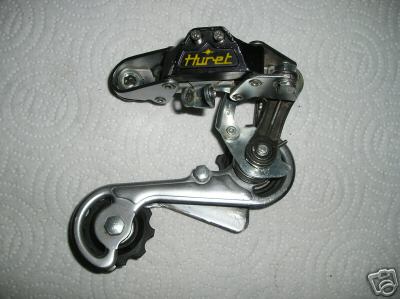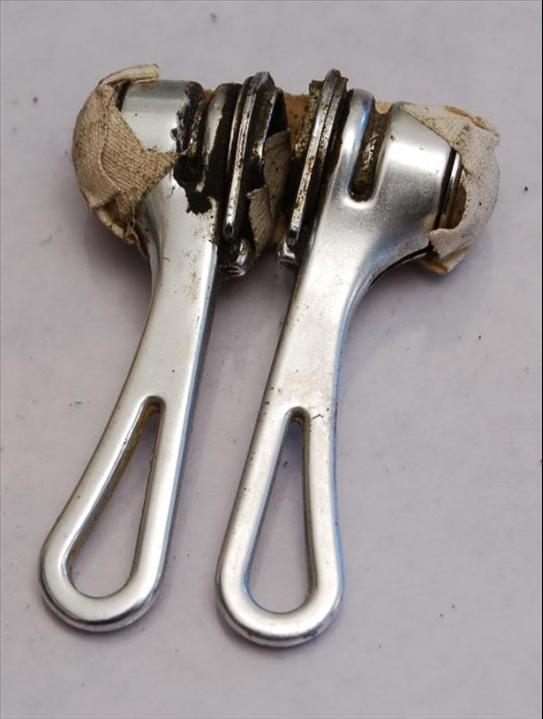Friction Shifting Question - Sachs-Huret Duopar Eco RD????
#1
OldSchool
Thread Starter
Friction Shifting Question - Sachs-Huret Duopar Eco RD????
I was reading a thread this morning that was discussing the pros and cons of various approaches to friction shifting on double and triple setups with large span freewheels in the rear to assist with steep ascents.
And one of the posters made this comment..... "Good shifting is the result of using either Shimano or Sachs freewheels, which have great tooth designs, and a Huret or Sachs-Huret Duopar Eco rear derailleur. It eliminates overshift and will handle a huge range of gear."
I am familiar with Shimano and Sachs freewheels, but have no knowledge at all of Huret or Sachs-Huret. What I would like to know is the basis or validity of the above statement, whether this Sachs-Huret model has some advantage over other friction rear derailleurs and how that advantage occurs mechanically. Thanks for any input.
And one of the posters made this comment..... "Good shifting is the result of using either Shimano or Sachs freewheels, which have great tooth designs, and a Huret or Sachs-Huret Duopar Eco rear derailleur. It eliminates overshift and will handle a huge range of gear."
I am familiar with Shimano and Sachs freewheels, but have no knowledge at all of Huret or Sachs-Huret. What I would like to know is the basis or validity of the above statement, whether this Sachs-Huret model has some advantage over other friction rear derailleurs and how that advantage occurs mechanically. Thanks for any input.
#2
Old fart
Join Date: Nov 2004
Location: Appleton WI
Posts: 24,782
Bikes: Several, mostly not name brands.
Mentioned: 153 Post(s)
Tagged: 0 Thread(s)
Quoted: 3587 Post(s)
Liked 3,398 Times
in
1,932 Posts
The name "Duopar" refers to the design; rather than a single parallelogram to position the chain, the Duopar has two. It has a standard parallelogram to move the chain across the freewheel cogs, and the second parallelogram moves vertically to keep the pulley at an optimum distance from the cogs. The result is very smooth and consistent shifting across a wide range of cog sizes.

The Duopar was available in two versions: a titanium body version with ball bearing pulleys, and the "Eco" version with a steel body and standard sleeve bearing pulley. They perform identically in my experience, and the "Eco" version is usually both cheaper and easier to find.
N.B. -- shift levers also make a difference. If you're using downtube levers, the Simplex "retrofriction" levers can't be beat, but they aren't cheap.


The Duopar was available in two versions: a titanium body version with ball bearing pulleys, and the "Eco" version with a steel body and standard sleeve bearing pulley. They perform identically in my experience, and the "Eco" version is usually both cheaper and easier to find.
N.B. -- shift levers also make a difference. If you're using downtube levers, the Simplex "retrofriction" levers can't be beat, but they aren't cheap.

#3
Senior Member
Join Date: Apr 2005
Location: Ann Arbor, MI
Posts: 16,874
Bikes: 1980 Masi, 1984 Mondonico, 1984 Trek 610, 1980 Woodrup Giro, 2005 Mondonico Futura Leggera ELOS, 1967 PX10E, 1971 Peugeot UO-8
Mentioned: 49 Post(s)
Tagged: 0 Thread(s)
Quoted: 1856 Post(s)
Liked 664 Times
in
506 Posts
I was reading a thread this morning that was discussing the pros and cons of various approaches to friction shifting on double and triple setups with large span freewheels in the rear to assist with steep ascents.
And one of the posters made this comment..... "Good shifting is the result of using either Shimano or Sachs freewheels, which have great tooth designs, and a Huret or Sachs-Huret Duopar Eco rear derailleur. It eliminates overshift and will handle a huge range of gear."
I am familiar with Shimano and Sachs freewheels, but have no knowledge at all of Huret or Sachs-Huret. What I would like to know is the basis or validity of the above statement, whether this Sachs-Huret model has some advantage over other friction rear derailleurs and how that advantage occurs mechanically. Thanks for any input.
And one of the posters made this comment..... "Good shifting is the result of using either Shimano or Sachs freewheels, which have great tooth designs, and a Huret or Sachs-Huret Duopar Eco rear derailleur. It eliminates overshift and will handle a huge range of gear."
I am familiar with Shimano and Sachs freewheels, but have no knowledge at all of Huret or Sachs-Huret. What I would like to know is the basis or validity of the above statement, whether this Sachs-Huret model has some advantage over other friction rear derailleurs and how that advantage occurs mechanically. Thanks for any input.
Because of the vertical parallelogram, the distance from where the chain reaches the sprocket and where it leaves teh jockey wheel is almost perfectly constant for any size of freewheel or cassette sprocket. Combined with a long cage, it also allows the mech to accommodate larger rear sprockets than probably any other triple or off-road rear mechs. In part the vertical parallelogram mimics the effect of an extra long derailleur hanger. In his landmark studies of rear derailleurs and what makes them work well (Bicycling Magazine in the late '70s/early ''80s, book "Upgrading your Bicycle," and the more recent book "The Dancing Chain"), Frank Berto discovered and verified that getting this distance correct and consistent is one of the main keys to good shifting, and that finding mechanism designs that accomplioshed that with linear travel enabled indexing. The old Campy Nuovo Record only gets it right over a narrow range of rear sprocket sizes. The Sun-Tour derived slant parallellogram (now used by every one) was another and ultimately more successful major step to getting it right over a wide range. Other good improvements included the Huret Allvit, the Simplex Prestige and siblings, and the Campy Croce d'Aune. But none went as far as the Duopar, and the modern Shimano are geometrically not quite as good, at least according to Berto's older assessments. But the simplicity of the Shimanos (and modern users of the slant design, such as Campy and SRAM) allows them to be made much more rugged than the Duopar.
For wide range vintage class, and good durability without impacts or other abuse, the Duopar is IMO the best ever. If you want more ruggedness or are going off road, or if you want your mechs to be both friction and index-compatible, look for a good used Suntour, a modern Shimano, or a modern Campagnolo. Well, I guess SRAM, too. There are others, but I'm not very familiar with them.
I like the Duopars a lot and have two of them in service. I'm very gentle with my bikes, but they might not be the best choice for every rider.
The basis and validity of my statement is in the writings and published test results of Frank Berto, dating back AFAIK to about 1979. My satisfied use is just minor confirmation of his results. But I'm not just blowing smoke here ...
Anybody know where the Bicycling Magazine articles might have been archived?
Thread
Thread Starter
Forum
Replies
Last Post
stridinggod
Classic & Vintage
4
08-22-15 12:17 PM
squirtdad
Classic & Vintage
15
08-14-15 06:51 AM
Velocivixen
Classic & Vintage
26
09-14-14 09:26 PM







